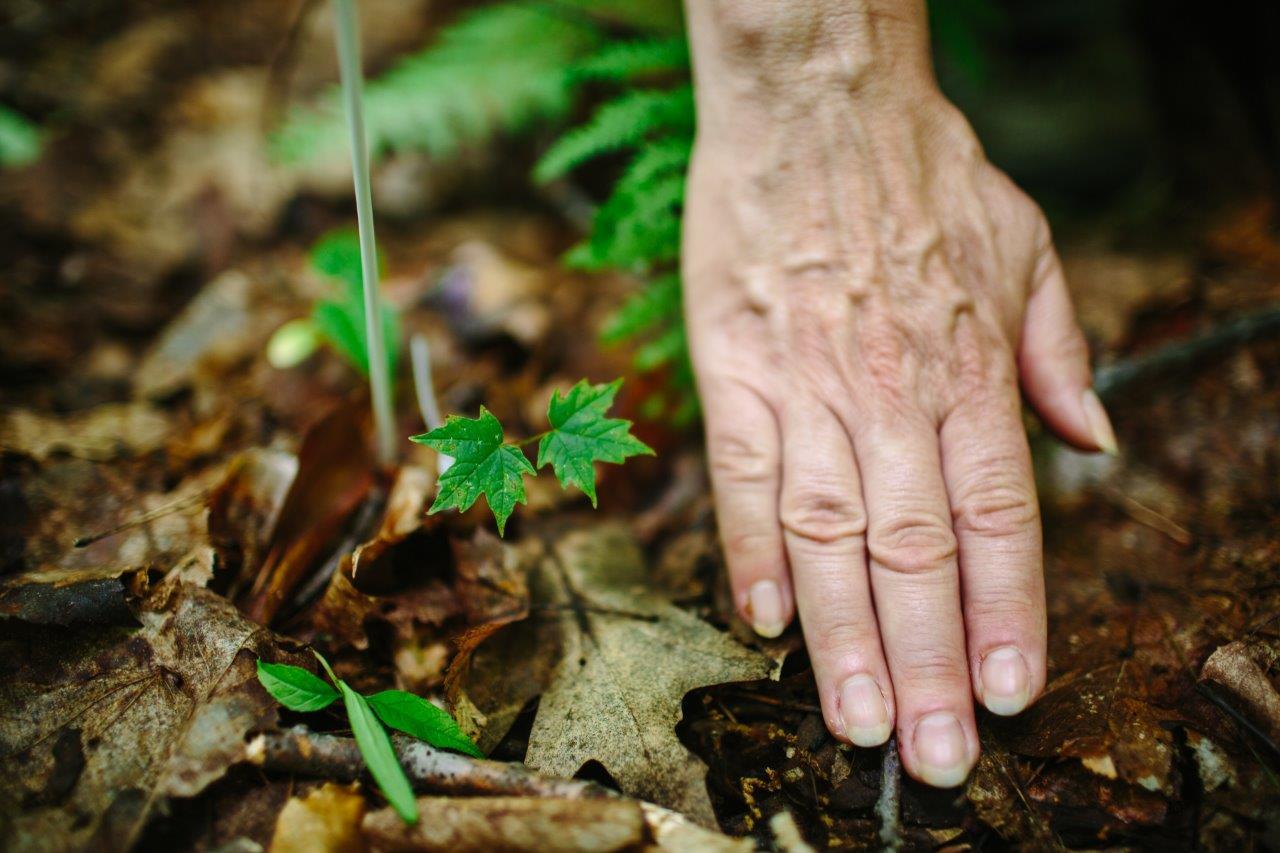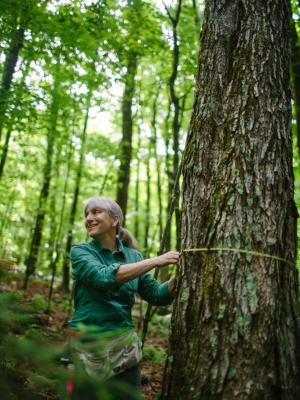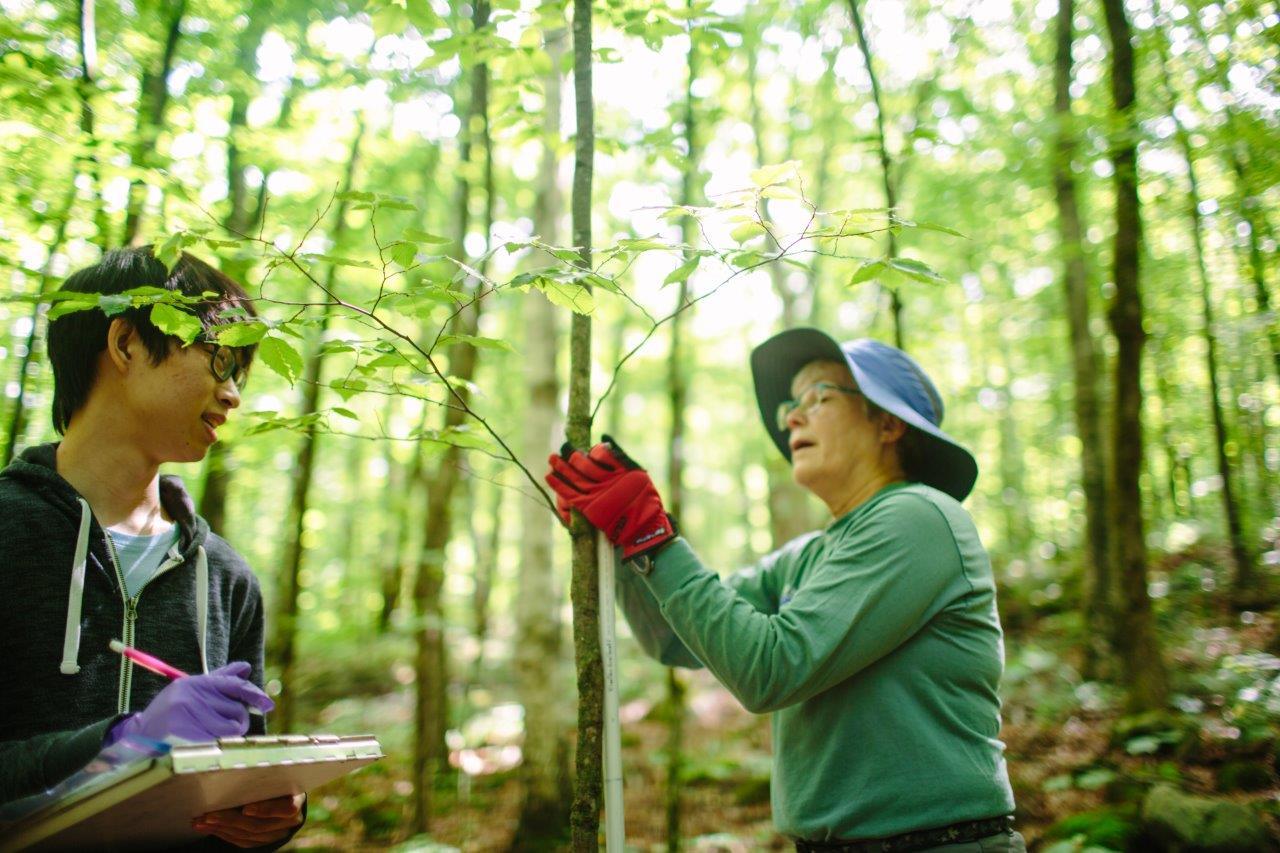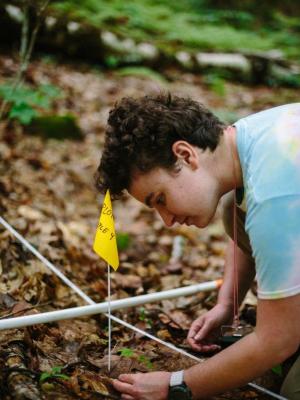Studying Sugar Maple Regeneration on Forest Society Lands
- Tags:
- Working Forests

Dr. Natalie Cleavitt thinks New Hampshire’s sugar maples may be having trouble growing up. Cleavitt is an ecologist with Cornell University who works primarily at Hubbard Brook Experimental Forest in Woodstock, N.H., where long-term research by the vegetation team (Tom Siccama, Tim Fahey, and John Battles) first documented a decline in growth rates of mature sugar maple, followed by elevated mortality in these trees. The decline was linked to consequences of soil acidification from acid rain, which both leaches calcium, an important plant nutrient, from the soil and mobilizes aluminum, a toxic element. In the early 2000s, Hubbard Brook ecologists began looking at sugar maple seedlings in the same forest, comparing them to seedlings in a watershed in which calcium had been carefully returned to the soil to match preindustrialization levels. What they found was that sugar maple seedling survivorship in the untreated reference watershed was three times lower than in the treated watershed, and everything from seedling leaf area to chlorophyll concentrations to mycorrhizal fungal associations were significantly lower in the untreated area. In simpler terms, the tree that draws tourists to our state with its incandescent foliage, slathers our waffles in delectably sweet syrup, and provides beautiful raw material for fine furniture and flooring, may be having trouble reproducing.

Sugar maples don’t produce seedlings every year. Masting tree species, such as maple, exhibit seed production that is highly variable by design. A sugar maple might not produce seeds one year and then follow that up with a synchronized bumper crop (many seeds) the following year. This reproductive strategy ensures that the number of seeds produced exceeds the capacity of seed-eating animals scavenging for them. Even in a good sugar maple mast year, which may happen only every 3–10 years, seedling survival is not high. Research at Hubbard Brook has shown that only about 30 percent of germinated “sugar babies” typically survive their first year, and Cleavitt and her team have witnessed worse than that. Following some mast years, entire seed cohorts have perished in their first season.
The causes of seedling failure are complex and multi-faceted, including soil acidification as well as increased insect and fungal invasions, climate warming, and competition from the American beech, another common northern hardwood tree. While soil acidification caused by acid rain may be slowly improving thanks to decades of air pollution control measures, the recovery of soil calcium will only occur on a geologic time scale from rock weathering. Factors such as insect pests and those caused by climate warming are likely to get worse in the near future. “Snowpack is extremely important for sugar maple health,” Cleavitt says. Without the insulation provided by snow, cold temperatures easily kill the fine roots responsible for uptake of minerals and water. Elevated spring temperatures can also be an issue without snowpack, as Cleavitt observed in 2012 when a spell of 80-degree-plus days before trees had leafed out killed 100 percent of the previous year’s mast crop. “The heat on the unshaded ground fried all the seeds before they could get their radicles, baby roots, into the soil,” Cleavitt explains. As climate models predict more frequent freeze-thaw events, reduced snowpack, and longer “vernal windows” between snowmelt and the emergence of vegetative growth, sugar maple seedlings face increased vulnerability. “Even when a seedling survives a snow-free winter,” Cleavitt notes, “it’s
at a disadvantage because it has to invest a lot of carbon to regrow those fine roots in the spring. That’s carbon it won’t be putting into other growth.”

In 2018, New Hampshire’s sugar maples had a good mast year. Cleavitt was interested in expanding her research to see whether the sugar maple regeneration failure she’d documented at Hubbard Brook was happening on a wider geographic scale. “The timing was right,” she says. “I’d waited almost a decade for this seed cohort and didn’t want to let it slip by.” Through a connection fostered by the Hubbard Brook Research Foundation (HBRF), she partnered with the Forest Society knowing that the organization has forested conservation land in all corners of the state as well as an army of engaged volunteers who steward those lands. Out of this partnership, the Sugar Maple Regeneration Community Science Project was born. In spring 2019, the Forest Society and Hubbard Brook trained 14 volunteer scientists who worked alongside Cleavitt and HBRF educator Sarah Thorne. The volunteers established and collected data at forty-eight plots on four forest reservations that span the latitudinal gradient of northern hardwood forest in the state: from south to north, Monadnock Reservation (Jaffrey), Yatsevitch Forest (Cornish), Sudrabin Forest (Orange), and Kauffmann Forest (Stark). Two summer research interns from Cornell University were also a key component of the project, thanks to an Engaged Cornell Research Grant. Research teams spent the summer measuring and tagging trees in 0.5 hectare circular plots, taking soil samples, and of course, marking and recording the condition of nearly 1,200 sugar babies. The individual seedlings will be tracked over many years to see how they fare, and additional seedling cohorts will be added as subsequent mast years occur. In future years, Cleavitt hopes to add additional study sites, as well as to involve high school students and teachers in studying primary productivity and seed production on some of the plots.

Volunteers appreciated the project’s “embedded researcher” model of fieldwork, which meant that Hubbard Brook researchers as well as Cornell undergraduates were working alongside volunteer scientists at all times, providing guidance and being available to answer technical questions as well as expound on big-picture inquires. “I loved looking at the woods in a more disciplined way, rather than just strolling through and enjoying it as I usually do,” said volunteer Dave Heuss. Blaine Kopp, another volunteer scientist, agreed that a deeper understanding of the science resulted from having regular access to researchers. “So much was unexpected about the research,” Kopp says. “I was constantly prompted to ask more questions; and it was great to have people there who could answer them.” The researchers, for their part, were impressed with both the Cornell students and the volunteers’ dedication and attention to detail. “We wanted to help people engage in real science,” Thorne says. “I was amazed at the caliber of the volunteers and their diverse backgrounds. It’s just a great, highly qualified group.” Everyone is striving for high data quality, as the ultimate goal for this research is publication in peer-reviewed scientific journals.
The inaugural year of the project also included making community connections with those managing northern hardwood forests in New Hampshire. Two stakeholder field visits were held in Cornish and Bethlehem, to which local landowners, foresters, and sugarmakers were invited to learn about the research and share ideas about the future of sugar maples in New Hampshire. Sugarmakers at the Yatsevitch Forest in Cornish admitted that they are typically thinking about mature sugar maples, or those that might be ready to tap in five to ten years, not the seedling layer. They didn’t know about Hubbard Brook’s seedling failure studies, but also weren’t surprised when Cleavitt talked about insect pests and reduced snowpack as contributing factors. Jim Taylor, who produced maple syrup from trees on the Yatsevitch Forest from 1992–2018, noted that the north-facing sugarbush at that location works to their advantage in terms of snowpack. “This is a cold woods,” he explained. “Weather comes up and over Mount Ascutney and just dumps snow on us. It melts slow here, and it’s slow to come to life in the spring.” This means sugarmakers here typically get 3–4 more runs of sap than other places might; but they were also happy to learn that in the long term it may be better for regeneration of the sugarbush.
The data collected in the Sugar Maple Regeneration Community Science Project’s first year are nowhere near complete enough to make predictions about whether the study will corroborate findings at Hubbard Brook in other areas of the state, but they do offer some tantalizing tidbits to mull over. Seedling leaf damage from insect and fungal pests increased from south to north in 2019, with the northernmost site, Kauffmann Forest in Stark, recording the worst leaf damage. Will these northernmost seedlings have a lower survival rate over the winter? Will differences in seed production explain some differences in seedling densities seen between sites? These are just a few of the questions that researchers and citizen scientists will be considering, eagerly waiting to discover what transpires on the Forest Society study plots in 2020 as they watch the sugar babies grow.
The Sugar Maple Regeneration Community Science Project is a partnership between the Forest Society, Hubbard Brook Research Foundation, and Cornell university, and has been generously supported by grants from uSdA NE Climate Hub, Cornell university Office of Engagement Initiatives, and the National Science Foundation.
The Sugar Maple Regeneration Community Science Project is currently looking for volunteers for our Kauffmann Forest study site in Stark, NH. If you are interested, please contact Carrie Deegan at cdeegan@forestsociety.org for more details.
